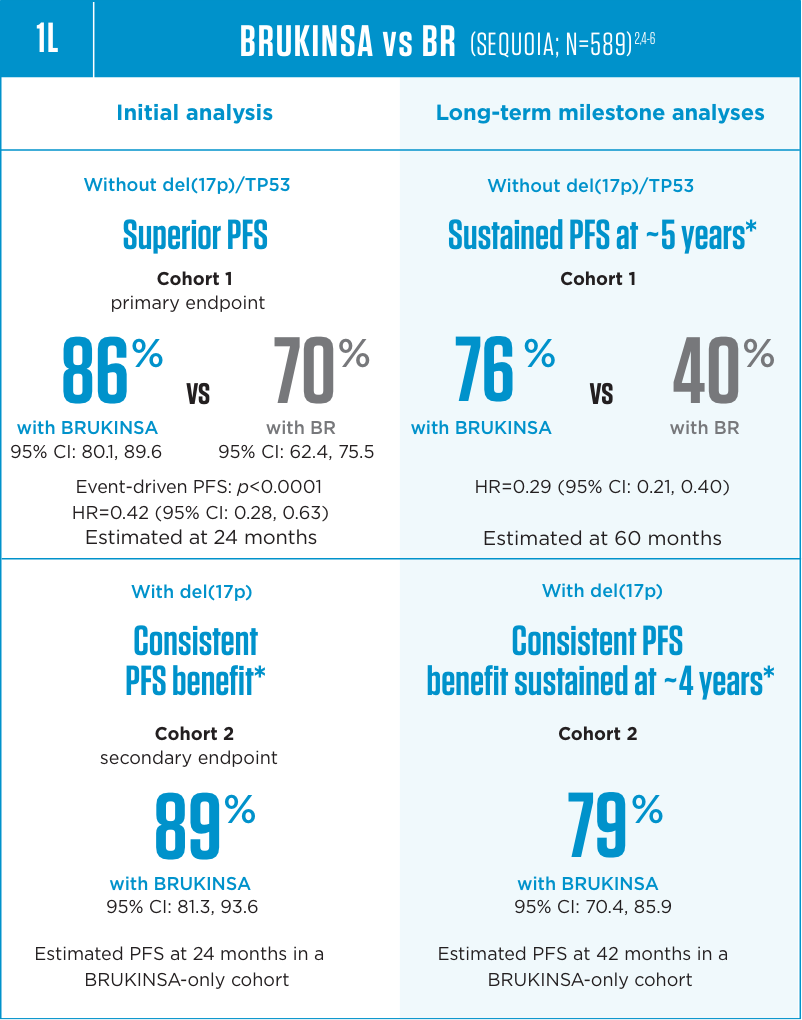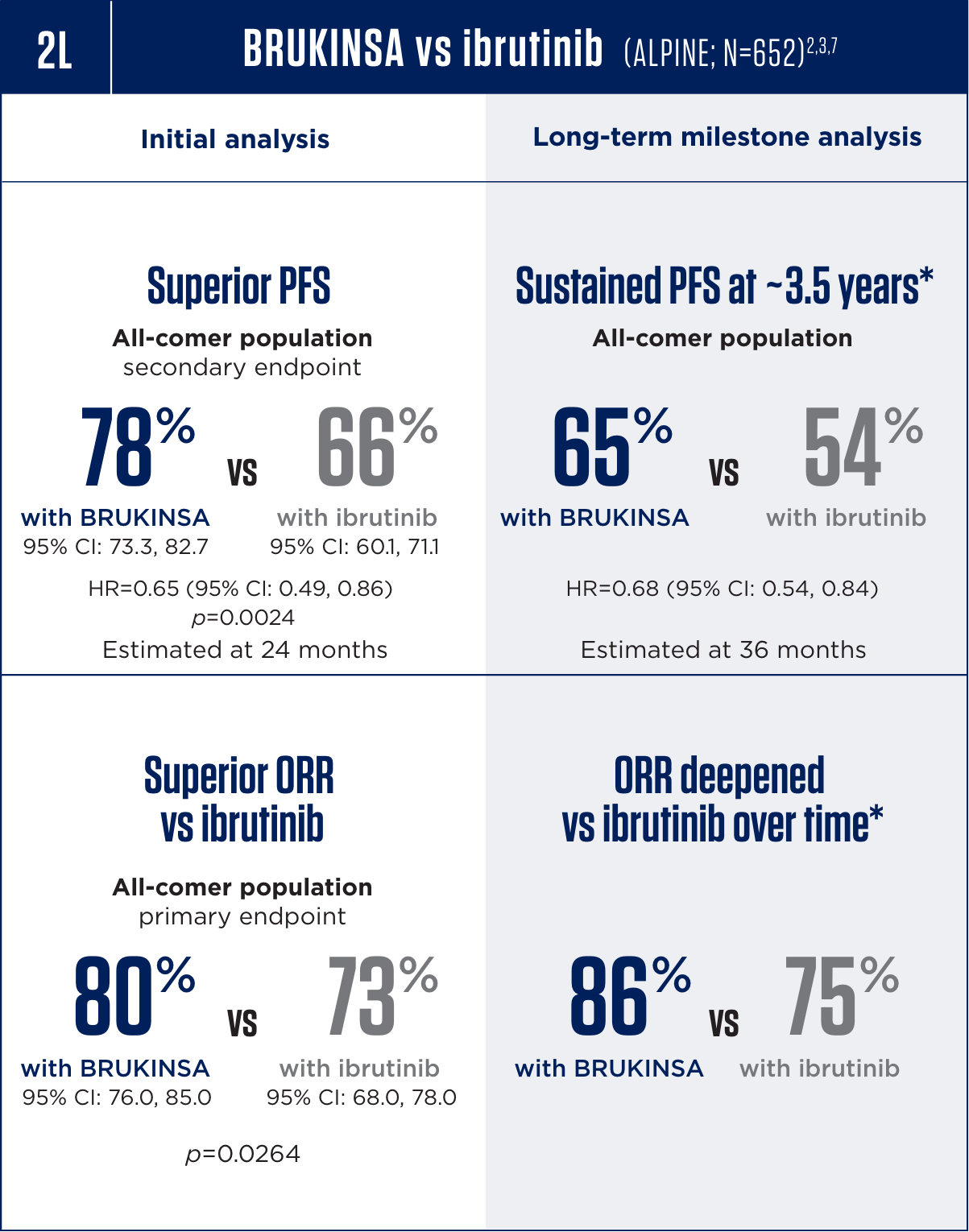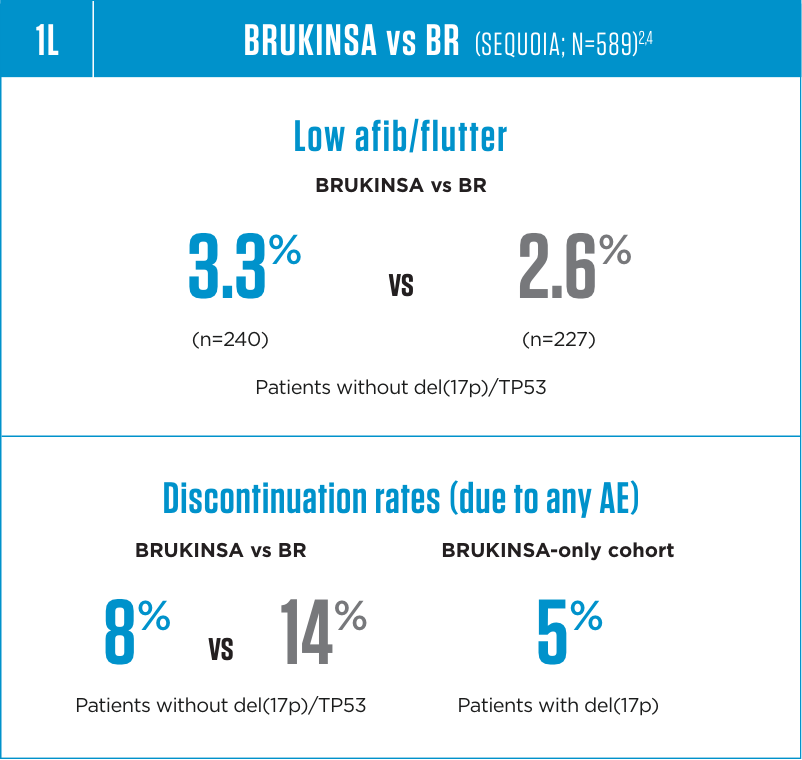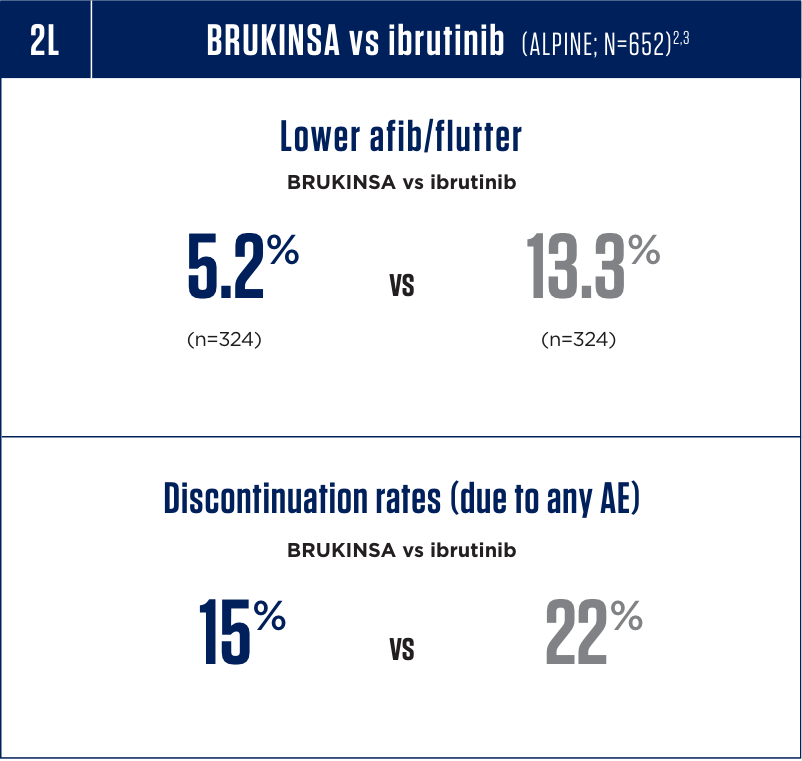BRUKINSA patients can call the myBeOne Support™ program to talk to a dedicated nurse: 1-833-234-4363
SEE THE MILESTONE ANALYSES DATA IN CLL
BRUKINSA: Now the leader in new patient starts in both 1L and 2L CLL
and the #1 prescribed BTKi across 4 other B-cell malignancies*1
*Based on September 2024 New Patient Starts from IQVIA LAAD claims, SHS PTD claims, and CareSet claims data.1
START STRONG WITH BRUKINSA
BRUKINSA was designed to meet the challenges of BTK inhibition, including in adult patients with CLL2
SUPERIOR EFFICACY ACROSS LINES OF THERAPY2-4
Median follow-up: 26.2 months for Cohort 1 and 30.5 months for Cohort 2 at the initial analysis; 61.2 months for Cohort 1 and 47.9 months for Cohort 2 at the long-term follow-ups.4-6

Median follow-up: 31 months for PFS and 24.7 months for ORR at the initial analysis; 42.5 months for PFS and ORR at the long-term follow-up.1,2,7
*All analyses are exploratory and descriptive in nature.
SEQUOIA was a global Phase 3, randomized, open-label, multicenter trial evaluating BRUKINSA vs BR in 479 patients with previously untreated CLL/SLL without del(17p)/TP53. 110 patients with del(17p) were evaluated in a separate single-arm cohort and received BRUKINSA only. The primary endpoint was PFS per IRC in the ITT population in the BRUKINSA arm and the BR arm, with minimum 2-sided alpha of 0.05 for superiority.2,4
ALPINE was a global Phase 3, randomized, open-label, multicenter trial evaluating BRUKINSA vs ibrutinib in 652 patients with relapsed/refractory CLL/SLL who received ≥1 prior systemic therapy. Statistical analysis for PFS and ORR were initially conducted for noninferiority. When noninferiority was met, superiority was tested.2,3
1L=first line; 2L=second line; BR=bendamustine+rituximab; BTK=Bruton’s tyrosine kinase; BTKi=Bruton’s tyrosine kinase inhibitor; CI=confidence interval; CLL=chronic lymphocytic leukemia; HR=hazard ratio; IRC=independent review committee; ITT=intent to treat; ORR=overall response rate; PFS=progression-free survival; SLL=small lymphocytic lymphoma.
VIEW LONG-TERM EFFICACY DATACONSISTENCY IN 2 GLOBAL PHASE 3 TRIALS

Median duration of treatment: 26.1 months for BRUKINSA and 5.6 months for BR in Cohort 1; 30.0 months for BRUKINSA in Cohort 2.4

Median duration of treatment: 28.4 months for BRUKINSA and 24.3 months for ibrutinib.3
Serious adverse reactions, including fatal events, have occurred with BRUKINSA, including hemorrhage, infections, cytopenias, second primary malignancies, cardiac arrhythmias, hepatotoxicity (including drug-induced liver injury), and embryo-fetal toxicity. In the pooled safety population (N=1729), the most common adverse reactions (≥30%), including laboratory abnormalities, in patients who received BRUKINSA were neutrophil count decreased (51%), platelet count decreased (41%), upper respiratory tract infection (38%), hemorrhage (32%), and musculoskeletal pain (31%).2
1L=first line; 2L=second line; AE=adverse event; afib=atrial fibrillation; BR=bendamustine+rituximab.
VIEW FULL SAFETY DATADr Anthony Nguyen discusses how BRUKINSA has benefited his patients
DISCOVER MORE VIDEOSZanubrutinib (BRUKINSA®) is a National Comprehensive Cancer Network® (NCCN®) preferred treatment option for patients with CLL8:
Without del(17p)/TP53
First-line: NCCN Category 1
Second-line: NCCN Category 1
With del(17p)/TP53
First-line: NCCN Category 2A
Second-line: NCCN Category 1

A personalized support program designed to help guide and assist patients, caregivers, and practices.
Access
Patients
Support
HEALTHCARE PROFESSIONAL RESOURCES
FIND TOOLS AND EDUCATION TO HELP YOUR PRACTICEIMPORTANT SAFETY INFORMATION
What should I tell my healthcare provider before taking BRUKINSA?
Before taking BRUKINSA, tell your healthcare provider about all of your medical conditions, including if you:
- have bleeding problems.
- have had recent surgery or plan to have surgery. Your healthcare provider may stop BRUKINSA for any planned medical, surgical, or dental procedure.
- have an infection.
- have or had heart rhythm problems.
- have high blood pressure.
- have liver problems, including a history of hepatitis B virus (HBV) infection.
- are pregnant or plan to become pregnant. BRUKINSA can harm your unborn baby. If you are able to become pregnant, your healthcare provider may do a pregnancy test before starting treatment with BRUKINSA.
- Females should avoid getting pregnant during treatment and for 1 week after the last dose of BRUKINSA. You should use effective birth control (contraception) during treatment and for 1 week after the last dose of BRUKINSA.
- Males should avoid getting female partners pregnant during treatment and for 1 week after the last dose of BRUKINSA. You should use effective birth control (contraception) during treatment and for 1 week after the last dose of BRUKINSA.
- are breastfeeding or plan to breastfeed. It is not known if BRUKINSA passes into your breast milk. Do not breastfeed during treatment with BRUKINSA and for 2 weeks after the last dose of BRUKINSA.
Tell your healthcare provider about all the medicines you take, including prescription and over-the-counter medicines, vitamins, and herbal supplements. Taking BRUKINSA with certain other medications may affect how BRUKINSA works and can cause side effects.
What are the possible side effects of BRUKINSA?
BRUKINSA may cause serious side effects, including:
- Bleeding problems (hemorrhage). Bleeding problems are common with BRUKINSA, and can be serious and may lead to death. Your risk of bleeding may increase if you are also taking a blood thinner medicine. Tell your healthcare provider if you have any signs or symptoms of bleeding, including:
- blood in your stools or black stools (looks like tar)
- pink or brown urine
- unexpected bleeding, or bleeding that is severe or you cannot control
- vomit blood or vomit that looks like coffee grounds
- cough up blood or blood clots
- increased bruising
- dizziness
- weakness
- confusion
- change in speech
- headache that lasts a long time
- Infections that can be serious and may lead to death. Tell your healthcare provider right away if you have fever, chills, or flu-like symptoms.
- Decrease in blood cell counts (white blood cells, platelets, and red blood cells). Your healthcare provider should do blood tests during treatment with BRUKINSA to check your blood counts.
- Second primary cancers. New cancers have happened in people during treatment with BRUKINSA, including cancers of the skin or other organs. Your healthcare provider will check you for other cancers during treatment with BRUKINSA. Use sun protection when you are outside in sunlight.
- Heart rhythm problems (atrial fibrillation, atrial flutter, and ventricular arrhythmias) that can be serious and may lead to death. Tell your healthcare provider if you have any of the following signs or symptoms:
- your heartbeat is fast or irregular
- feel lightheaded or dizzy
- pass out (faint)
- shortness of breath
- chest discomfort
- Liver problems. Liver problems, which may be severe or life-threatening, or lead to death, can happen in people treated with BRUKINSA. Your healthcare provider will do blood tests to check your liver before and during treatment with BRUKINSA. Tell your healthcare provider or get medical help right away if you have any signs of liver problems, including stomach pain or discomfort, dark-colored urine, or yellow skin and eyes.
The most common side effects of BRUKINSA include:
- decreased white blood cell count
- decreased platelet count
- upper respiratory tract infection
- bleeding
- muscle, bone, or joint pain
These are not all the possible side effects of BRUKINSA. Call your doctor for medical advice about side effects. You may report side effects to FDA at 1-800-FDA-1088.
What is BRUKINSA?
BRUKINSA is a prescription medicine used to treat adults with:
- Chronic lymphocytic leukemia (CLL) or small lymphocytic lymphoma (SLL).
- Waldenström’s macroglobulinemia (WM).
- Mantle cell lymphoma (MCL) who have received at least one prior treatment for their cancer.
- Marginal zone lymphoma (MZL) when the disease has come back or did not respond to treatment and who have received at least one certain type of treatment.
- Follicular lymphoma (FL), in combination with the medicine obinutuzumab, when the disease has come back or did not respond to treatment and who have received at least two prior treatments.
It is not known if BRUKINSA is safe and effective in children.
Please see full Prescribing Information including Patient Information.

